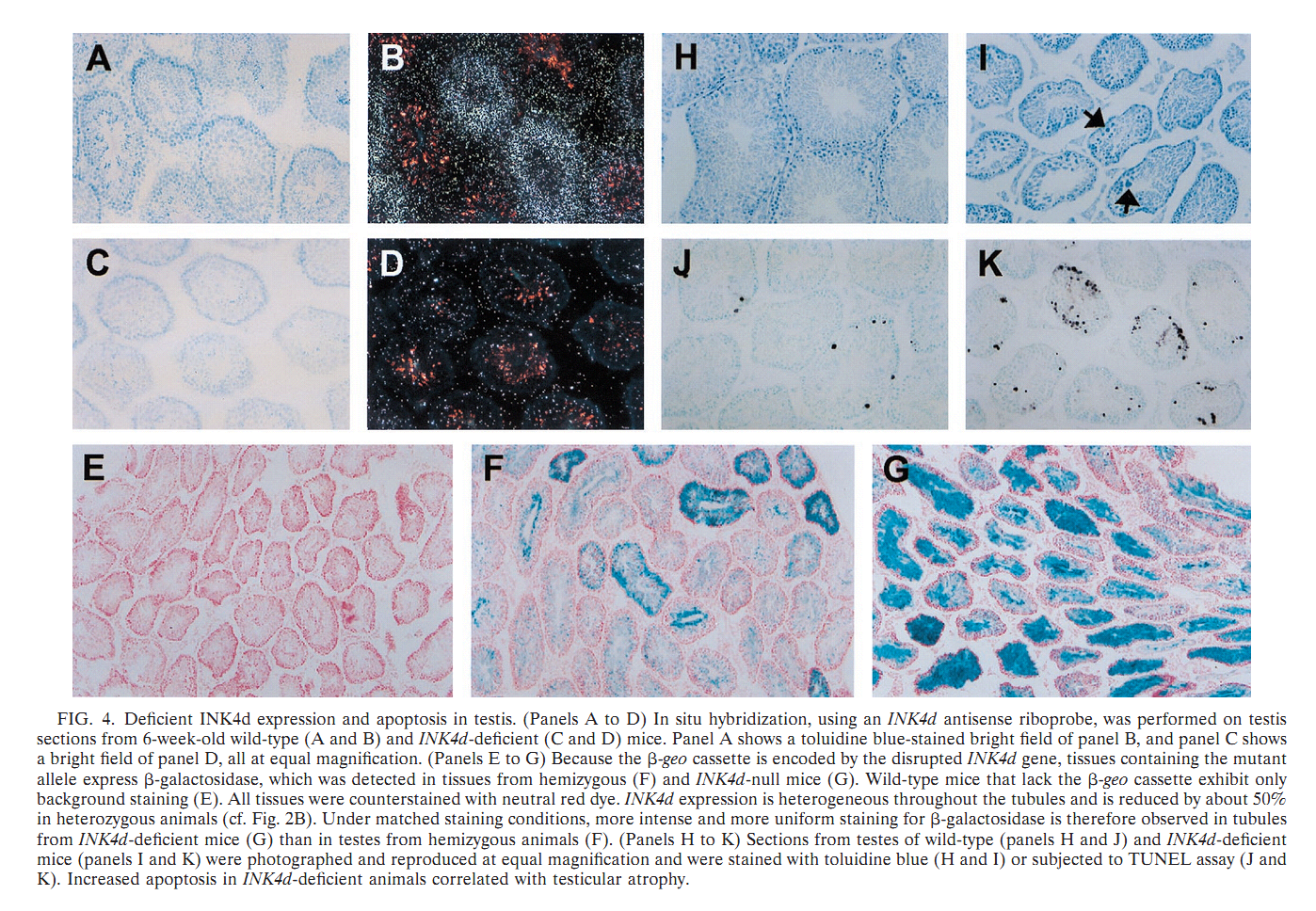| Tag | Content | ||||||||||||
|---|---|---|---|---|---|---|---|---|---|---|---|---|---|
SG ID |
SG00001620 |
||||||||||||
UniProt Accession |
|||||||||||||
Theoretical PI |
5.79
|
||||||||||||
Molecular Weight |
17809 Da
|
||||||||||||
Genbank Nucleotide ID |
|||||||||||||
Genbank Protein ID |
|||||||||||||
Gene Name |
Cdkn2d |
||||||||||||
Gene Synonyms/Alias |
|||||||||||||
Protein Name |
Cyclin-dependent kinase 4 inhibitor D |
||||||||||||
Protein Synonyms/Alias |
p19-INK4d; |
||||||||||||
Organism |
Mus musculus (Mouse) |
||||||||||||
NCBI Taxonomy ID |
10090 |
||||||||||||
Chromosome Location |
|
||||||||||||
Function in Stage |
|||||||||||||
Function in Cell Type |
|||||||||||||
Description |
Temporarily unavailable |
||||||||||||
The information of related literatures |
1. A. Gromley, M. L. Churchman, F. Zindy and C. J. Sherr (2009) Transient expression of the Arf tumor suppressor during male germ cell and eye development in Arf-Cre reporter mice. Proc Natl Acad Sci U S A 106(15): 6285-90. Abstract The Arf tumor suppressor is expressed transiently during mouse male germ cell and eye development. Its inactivation compromises spermatogenesis as mice age and leads to aberrant postnatal proliferation of cells in the vitreous of the eye, resulting in blindness. In the testis, expression of p19(Arf) is limited to spermatogonia but is extinguished completely in spermatocytes, suggesting that Arf plays a physiologic role in setting the balance between mitotic and meiotic germ cell division. A knock-in allele encoding Cre recombinase regulated by the mouse cellular Arf promoter was used to trace Arf gene induction in vivo. Interbreeding to a reporter strain that expresses Cre-dependent YFP provided proof-of-principle that the Arf-Cre allele was appropriately expressed in the male germ cell lineage. However, Cre expression resulted in male sterility, limiting germ line transmission of the knock-in allele to females. Arf-null mice fail to resorb the hyaloid vasculature within the ocular vitreous where pericyte-like cells that express the PDGF-beta receptor (Pdgfrbeta) proliferate aberrantly and destroy the retina and lens. Interbreeding of Arf-Cre females to males containing "floxed" (FL) Arf alleles yielded Arf(Cre/FL) progeny that exhibited variably penetrant defects in visual acuity ranging to total blindness. Crossing the Arf(Cre/FL) alleles onto a Pdgfrbeta(FL/FL) background normalized all histopathology and restored vision fully. PMID: [19339492] 2. F. Zindy, J. van Deursen, G. Grosveld, C. J. Sherr and M. F. Roussel (2000) INK4d-deficient mice are fertile despite testicular atrophy. Mol Cell Biol 20(1): 372-8. Abstract The INK4 family of cyclin-dependent kinase (CDK) inhibitors includes four 15- to 19-kDa polypeptides (p16(INK4a), p15(INK4b), p18(INK4c), and p19(INK4d)) that bind to CDK4 and CDK6. By disrupting cyclin D-dependent holoenzymes, INK4 proteins prevent phosphorylation of the retinoblastoma protein and block entry into the DNA-synthetic phase of the cell division cycle. The founding family member, p16(INK4a), is a potent tumor suppressor in humans, whereas involvement, if any, of other INK4 proteins in tumor surveillance is less well documented. INK4c and INK4d are expressed during mouse embryogenesis in stereotypic tissue-specific patterns and are also detected, together with INK4b, in tissues of young mice. INK4a is expressed neither before birth nor at readily appreciable levels in young animals, but its increased expression later in life suggests that it plays some checkpoint function in response to cell stress, genotoxic damage, or aging per se. We used targeted gene disruption to generate mice lacking INK4d. These animals developed into adulthood, had a normal life span, and did not spontaneously develop tumors. Tumors did not arise at increased frequency in animals neonatally exposed to ionizing radiation or the carcinogen dimethylbenzanthrene. Mouse embryo fibroblasts, bone marrow-derived macrophages, and lymphoid T and B cells isolated from these animals proliferated normally and displayed typical lineage-specific differentiation markers. Males exhibited marked testicular atrophy associated with increased apoptosis of germ cells, although they remained fertile. The absence of tumors in INK4d-deficient animals demonstrates that, unlike INK4a, INK4d is not a tumor suppressor but is instead involved in spermatogenesis. PMID: [10594039] Back to Top |
||||||||||||
Figures for illustrating the function of this protein/gene |
|
||||||||||||
Function |
Interacts strongly with CDK4 and CDK6 and inhibits them. Back to Top |
||||||||||||
Subcellular Location |
Nucleus (By similarity). Cytoplasm (Bysimilarity). |
||||||||||||
Tissue Specificity |
|||||||||||||
Gene Ontology |
|
||||||||||||
Interpro |
|||||||||||||
Pfam |
|||||||||||||
SMART |
|||||||||||||
PROSITE |
|||||||||||||
PRINTS |
|||||||||||||
Created Date |
18-Oct-2012 |
||||||||||||
Record Type |
Experiment identified |
||||||||||||
Protein sequence Annotation |
CHAIN 1 166 Cyclin-dependent kinase 4 inhibitor D. /FTId=PRO_0000144189. REPEAT 41 69 ANK 1. REPEAT 73 102 ANK 2. REPEAT 106 135 ANK 3. REPEAT 138 165 ANK 4. MOD_RES 1 1 N-acetylmethionine (By similarity). CONFLICT 16 16 A -> R (in Ref. 1; AAC52194). CONFLICT 17 17 A -> P (in Ref. 2; AAA85437). HELIX 7 17 HELIX 21 29 HELIX 45 48 HELIX 54 62 TURN 72 74 HELIX 77 84 HELIX 87 95 HELIX 110 117 HELIX 120 126 HELIX 127 129 HELIX 142 148 HELIX 152 160 Back to Top |
||||||||||||
Nucleotide Sequence |
Length: 941 bp Go to nucleotide: FASTA |
||||||||||||
Protein Sequence |
Length: 166 bp Go to amino acid: FASTA |
||||||||||||
The verified Protein-Protein interaction information |
| ||||||||||||
Other Protein-Protein interaction resources |
String database |
||||||||||||
View Microarray data |
|||||||||||||
Comments |
|||||||||||||


